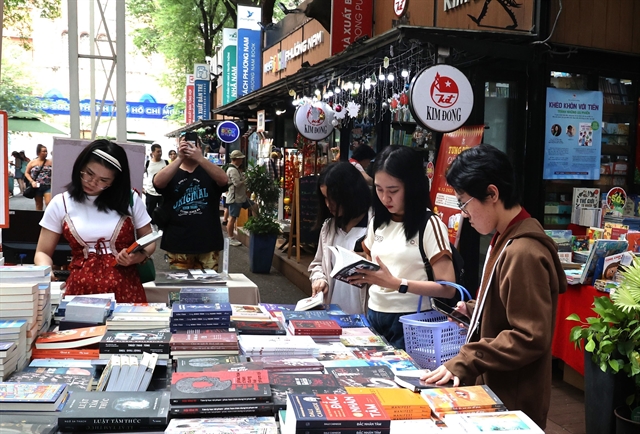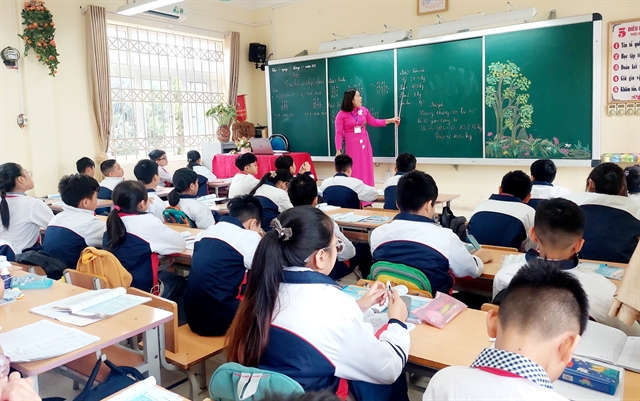 Life & Style
Life & Style

An art show entitled Tứ Phủ (Four Palaces ) was held last week at Hà Nội’s Công Nhân Theatre. It was one of the activities being organised to celebrate International Francophone Day in Việt Nam.
An art show entitled Tứ Phủ (Four Palaces ) was held last week at Hà Nội’s Công Nhân Theatre. It was one of the activities being organised to celebrate International Francophone Day in Việt Nam.
Four Palaces, produced by high-profile director Việt Tú, is based on the hầu đồng (trance ritual) ceremony, a Mother Goddess worship ritual known to be an oldest belief in Việt Nam.
Culture Vulture speaks to Việt Tú about his latest work.
About 30 ambassadors and representatives of Francophone countries and other countries watched Four Palaces on March 22. Many of them stood up and danced at the end of the show. Were you there?
 |
| Việt Tú. — VNS Photo |
The show on March 22 evening is very moving. I want to thank ambassador Phạm Sanh Châu, general secretary of the Việt Nam National UNESCO Committee, who supported and promoted Four Palaces among foreign diplomats and representatives of non-government organisations in Việt Nam.
I can say that it was one of the most successful nights, despite the nearly 100 shows of Four Palaces that have been held.
When I saw many foreign spectators standing up and dancing, I knew I was on the right path.
It proves that culture has no barriers. The enthusiastic welcome on the night of March 22 and other shows have made me more confident.
Why do you say that?
At the beginning, when I invited people to see Four Palaces, I received a variety of feedback. Though the opinions were not negative, some spectators said Four Palaces was suitable for foreigners only.
After the show, an American spectator said he was attracted by Four Palaces. What did you think first when you made the show?
The only thing I did while making Four Palaces was to ensure accuracy because I’m a Buddhist. When spectators enter the theatre, they will calm down, enjoying the decorations in the hall, along with burning incense. It helps spectators feel meditative and respect Vietnamese religion.
Four Palaces inspires various feelings that keep the spectators seated during the show, and at its end, can make them jump out of their seats and dance.
It is like being in a real hầu đồng (going into a trance) ceremony where the medium throws sweets around for good luck, and nobody can sit still at the end of the ceremony.
Why did you choose three out of the total of 36 deities in Four Palaces?
I think all spectators will be moved when they see the performance of the medium, switching between three deities.
I choose three typical deities out the total 36 and combined them with professional stage skills to make Four Palaces.
Most of the spectators said they didn’t understand much of the plot, but the stage was beautiful and attracted them.
A Canadian spectator said as a foreigner in Việt Nam, he would like to know more about its unique culture and that he had liked the show a lot.
He told me that ‘good feeling’ was more important than ‘good meaning’ because when he has a good feeling, he would find what the good meaning is.
How did the idea of Four Palaces come to you?
It is a long story. My mother was an actress in Thăng Long Water Puppetry Theatre. When I was small, she used to take me to her troupe’s performances. I got the chance to watch and understand how water puppetry artists taught young artists. I understood that traditional culture is very unique and beautiful.
I go abroad every year to see art shows in large cities to update my knowledge.
I dream of owning a small theatre such as in West End or Broadway to do something. However, I have to brainstorm what I should do. Many people have suggested that I should produce water puppetry shows that have lured foreign tourists. But I don’t want to produce such shows.
Then I was asked to watch an hầu đồng ceremony by one of my relatives. When I saw the place where the ceremony was being held, I knew it was what I was looking for.
What difficulties did you face while making Four Palaces?
I prayed to deities before producing Four Palaces, because I think that it is related to religion. I asked a veteran medium who helped me to pray 18 times to get a ‘smiling coin’. It meant the deities had approved my efforts to make Four Palaces.
The medium told me it was fate. I was chosen to do it but there would be many difficulties. That was true. When I began researching hầu đồng, there were many difficulties. I don’t remember how many times I wanted to quit.
First, I needed to thoroughly understand hầu đồng. However, I think all writers of hầu đồng documents are not insiders. I had to learn from the practitioners.
Second, hầu đồng shows have been performed in different places such as Việt Nam Tuồng (traditional opera) Theatre; Chuông Vàng Cải Lương (reformed theatre) Troupe; and Việt Nam Chèo (popular opera) Theatre.
What I had to do was to keep Four Palaces accurate and true to the traditional ceremony and also make it distinctive.
Do you think Four Palaces will be a vivid example for UNESCO’s approval of hầu đồng and Đạo Mẫu (Mother Goddess worship) as national intangible cultural heritage?
The dossier of hầu đồng and Đạo Mẫu was submitted to the UNESCO in 2014 and will be reviewed in December.
Four Palaces is an activity on the sidelines, showing hầu đồng as one of the important ceremonies in Việt Nam. It helps people to see how traditional culture impacts modern culture and art activities. — VNS









